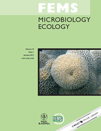The phylogenetic distribution and ecological role of carbon monoxide oxidation in the genus Burkholderia
Abstract
Burkholderia is a physiologically and ecologically diverse genus that occurs commonly in assemblages of soil and rhizosphere bacteria. Although Burkholderia is known for its heterotrophic versatility, we demonstrate that 14 distinct environmental isolates oxidized carbon monoxide (CO) and possessed the gene encoding the catalytic subunit of form I CO dehydrogenase (coxL). DNA from a Burkholderia isolate obtained from a passalid beetle also contained coxL as do the genomic sequences of species H160 and Ch1-1. Isolates were able to consume CO at concentrations ranging from 100 ppm (vol/vol) to sub-ambient (< 60 ppb (vol/vol)). High concentrations of pyruvate inhibited CO uptake (> 2.5 mM), but mixotrophic consumption of CO and pyruvate occurred when initial pyruvate concentrations were lower (c. 400 μM). With the exception of an isolate most closely related to Burkholderia cepacia, all CO-oxidizing isolates examined were members of a nonpathogenic clade and were most closely related to Burkholderia species, B. caledonica, B. fungorum, B. oxiphila, B. mimosarum, B. nodosa, B. sacchari, B. bryophila, B. ferrariae, B. ginsengesoli, and B. unamae. However, none of these type strains oxidized CO or contained coxL based on results from PCR analyses. Collectively, these results demonstrate that the presence of CO oxidation within members of the Burkholderia genus is variable but it is most commonly found among rhizosphere inhabitants that are not closely related to B. cepacia.




